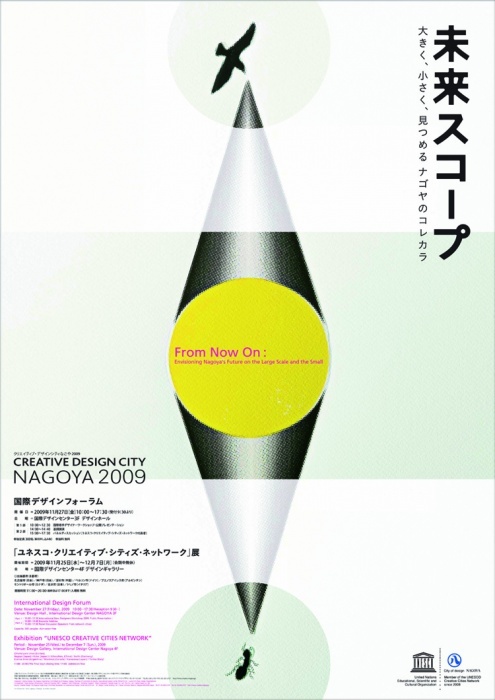- home>
- reports>
- news-report>
- The Significance of Networking
| 2014.02.13 |
|
The Significance of Networking
As a member of the Creative Design City Nagoya 2009 Organizing Committee, I participated in the International Design Forum’s workshop and panel discussion. In reflecting here on the Design Forum, I would like to reconfirm Nagoya’s position as a member city of the UNESCO Creative Cities Network.
The panel discussion allowed a representative of each Network city to report on experiences, ideas and practices, eliciting great interest from the audience. A brief overview follows.
Buenos Aires and Shenzhen have undertaken a variety of measures intended to promote industry, using design as an incentive for economic development. It was my impression that Kobe and Montreal attach importance to the historical context while stressing consciousness of design fostered to benefit the environment. Berlin reported examples of the creation of various experimental spaces in the search for the possibilities of continuously fluctuating design produced by changing the existing paradigm. In Nagoya, I would say that design is positioned as a fusion of two elements: a manufacturing industry that has inherited a tradition of monozukuri (making things) and a creative perspective focusing on the cultivation of community that is facilitated by the power of youth. Even before Nagoya’s endorsement as a member of the Network, there were sub-networks connecting individuals in diverse fields, such as education, culture and industry. These networks are known to have played a role in leading the trends of the times.
From this overview, we can recognize differences in the status quo of design among the Network cities. This forum seemed to be an argument to solidify the significance of the Network itself. Thanks to its admission into the Network, people around the world use the same language―design―to speak about our city. Comparison is only possible if we share a common language. Because I moderated the panel discussion, I was fortunate enough to be invited to the forum held in Kobe. There, an audience member expressed the opinion that networking leads to homogeneity. On the contrary, comparison helps us see contrast, or differences. By which I mean that the characteristics of a locale are confirmed in relativity to an area outside of that locale.
The overall theme of Creative Design City Nagoya 2009 was “sustainability”.
The role design needs to play as a means of constructing a sustainable future is extremely significant. Activities that benefit both man and the environment need to be thought of as “sustainable design”, while the concept of inclusive design should be shared as a more comprehensive initiative that accommodates all mankind. In this respect, the terms “sustainable” and “inclusive” do not indicate those exclusively used in the design field, but are regarded as terms belonging to an ideology or philosophy. Citizens can share and discuss design that does not take a form, rather than the design that requires specialized skills and deals with the shapes and other physical attributes of objects and such. That is, what will be the foundation of a design city of the future is not design as a set of professional skills, but a set of life skills. Certainly, in this workshop, as in the past, beginning designers witnessed professional activities and worked on their several and various projects, but the discoveries made all over Nagoya under the theme “What we can do for the future” were definitely due to the citizens’ perspective. To put it more precisely, each participant wanted to share with the citizens. One of the greatest takeaways must have been the recognition, once again, of their design capacity, as in “life skills”.
People involved in design or art in Japan are well aware that the term sakka refers to someone who makes things. However, it is generally regarded as synonymous with “writer”. But if you introduce yourself as a sakka to anyone in Kanazawa, in Hokuriku, you will naturally be asked, “What do you make?” This example illustrates the dormant power in Kanazawa, proud to be a city of crafts, with a very long history. When we look more carefully at the example, we find that the production process itself is very meaningful to the people of Kanazawa. Their high level of craftsmanship is based on a thorough division of labor, and even those with no direct relationship to the crafts industry find themselves involved in the elaborate network of the division of labor, whether they like or not. In the Japan of yore, when people more commonly shared a sense of the value of creativity, ordinary citizens understood the meaning of craft, which we now call design, as the production process, rather than the integrated, final form.
Each Japanese Network city describes its sense of creativity with a particular word or phrase. Kanazawa’s is “the aesthetics of utility” (in crafts). Kobe’s is “fashion” and Nagoya’s is “monozukuri” (making things/manufacturing). In these phrases we recognize the clear differences that we Japanese have grown up understanding. This discernment of differences is synonymous with what is signified by the term “design”. Thanks to networking, we recognize the quality of information concerning the individuality of each locale, an individuality that depends on these differences. In due course, with the active interchange encouraged by Network membership, the quality of information will improve, in turn inspiring our daily life so that we can feel in our bones the process of creative activity.
At IdcN, Nagoya’s tradition of monozukuri intersects with the ambitious efforts of the next generation; Nagoya is the training ground for the opposing designs: that of professional skills, and that of life skills. Herein lies the identity of our city among the other Network cities.
(First appearance: Creative Design City Nagoya Annual Report/May, 2010)
*Related reports can be found on the official website of Creative Design City Nagoya.
Takayuki Ikegawa
- Report: Nagoya, UNESCO City of Design Promotion Projects FY 2013
- Report: creators shop Loop(Fourth and Fifth Session)
- Report: 2013 Nagoya City Emergency Job Creation Projects
Creative Industry Cooperative Promotion Projects - Report: Corporate Support・Design Planning and Production FY 2013
- Report: IdcN Design Promotion FY 2013
- Report|Design Tour: Fun with the Classics at Yokiso’s Choshokaku
- Electric Media: The Age of Radio
- Ziggurat Design 30s “American Art Deco and Skyscrapers”
- “LIFE” | America: Birth of Photojournalism Magazine
- American AD of 1930s | Lifestyle and Products
- Electric Dream: Household Electric Appliance and Modern Life
- Posters from the 30s: Modern Life and Graphic Design















